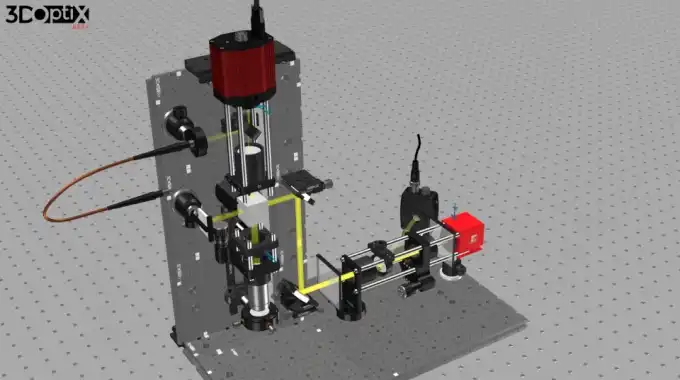In an ever-changing industrial world, the conversion of CAD formats to other formats suitable for specific applications has become essential. Companies specialized in diverse fields such as optical design, nuclear simulation, industrial automation, and even 3D printing face complex challenges in data interoperability. Thanks to advanced solutions like CAD Exchanger, these challenges are successfully overcome. Through several case studies - including 3DOptix, Cyclife Digital Solutions, GCAS, OMRON, and RUHRSOURCE - these testimonials aim to demonstrate how flexibility in CAD format management can bring significant added value to different sectors. Whether you are a decision-maker, IT manager, or engineer, the insights here could be crucial for future technological advancements.
3DOptix: Mastering STEP to Mesh Conversion for Optical Simulation

In the rapidly evolving field of optical design, the need for agile and precise solutions is more critical than ever. This is where 3DOptix excels, offering an innovative cloud platform for optical simulation and prototyping. However, as in any high-tech environment, challenges remain, especially regarding data format conversion. Let's discover how 3DOptix solved this issue using CAD Exchanger Cloud API.
- The Company: 3DOptix is a leading company in optical design, providing a native cloud platform dedicated to optical simulation and prototyping. This comprehensive solution offers various features, including digital twin design, optical performance simulation, and easy design sharing through their 3DOptix Warehouse platform. Designed for academic and industrial environments, it offers realistic simulations with diverse optical catalogs.
- The Product: A cloud tool for optical simulation. This unique software allows users to upload their optical parts and equipment, requiring the conversion of traditional optomechanical formats like STEP, Parasolid, and SOLIDWORKS into meshes.
- The Challenge: The main obstacle was the conversion of optomechanical formats into meshes for optical simulations.
- The Solution: CAD Exchanger Cloud API was the answer to this challenge.
What makes CAD Exchanger Cloud API indispensable for 3D web applications? Here are some of its essential advantages:
- Multi-format Compatibility: Supports all major 3D formats, including STEP, Solidworks, JT, STL, and many more.
- Comprehensive Tools: Offers a complete toolchain for online visualization, exchange, and real-time collaboration around 3D CAD data.
- Easy Integration: Easily integrates with popular libraries like three.js for seamless conversions.
- Extensive Features: Rich JavaScript and native APIs for exploring 3D assemblies, B-Reps, and meshes.
- Advanced Management: Allows assembly and part management to create hierarchical product structure views.
- Web Visualization: Interactive 3D visualization in the browser, enhanced by interactive 3D widgets or full user interfaces.
- Fast Transfers: Optimized file format for the web to minimize transfer times.
- Added Value: CAD Exchanger Cloud API proved indispensable for 3DOptix, ensuring reliable conversions and seamless compatibility with web browsers.
Cyclife Digital Solutions: Optimizing Nuclear Operations with STEP Support

If you are in the nuclear industry, and 3D simulation is integral to your workflow, you'll understand the importance of robust and versatile software. Cyclife Digital Solutions (Cyclife DS) meets this need with DEMplus® for nuclear simulation.
- Company Overview: Cyclife DS provides advanced 3D simulation solutions for nuclear facilities. DEMplus® not only allows planning and monitoring operations but also analyzes various factors such as radiation dose, equipment performance, and even physical characteristics of waste.
- The Challenge: A major challenge for Cyclife DS is the need to import various types of 3D models for simulations. These models come from different sources, including 2D plans, 3D scans, and photogrammetry.
- The Technological Solution: Cyclife DS chose to integrate CAD Exchanger SDK for several reasons. Among them:
- Versatile Data Models: Capable of handling CAD, BIM, B-Rep, and other data models.
- Visualization Features: Offers web and desktop visualization options, including exploded views and measurements.
- Advanced Analysis: Surface and curve evaluation, measurements, and powerful algorithms for error detection and repair.
- Large File Optimization: Efficient handling of large-sized files.
- Added Value: CAD Exchanger SDK significantly accelerated the development of DEMplus® for Cyclife DS. Through its direct integration, Cyclife DS was able to add support for multiple formats with minimal effort.
The adoption of CAD Exchanger SDK by Cyclife DS proved to be a wise choice, reducing deployment time and enhancing the versatility of their flagship product, DEMplus® for nuclear simulation.
GCAS: Process Optimization through STEP to X3D Conversion
Here's a striking example of how CAD Exchanger SDK enabled GCAS Inc., a leading technology player in the military and intelligence fields, to overcome interoperability challenges and improve their Corrosion Expert System (CES).
- Company Background: GCAS Inc. is a top technology player serving the U.S. national defense missions for over a quarter-century.
- The CES System: GCAS developed ACES, a simulation and modeling solution aimed at anticipating vehicle degradation due to corrosion over time.
- Technical Challenge: The system was previously hindered by a reliance on outdated third-party C++ software for STEP model conversion, complicating finite element-based analysis.
- Intervention Strategy: The adoption of CAD Exchanger SDK streamlined the process by directly importing STEP files into the X3D format. This replaced the need for finite element meshes, making the process more efficient.
- Significant Impact: With the new structure incorporating CAD Exchanger, ACES experienced a notable performance improvement and more optimized memory usage. This accelerated the processing and display of 3D geometries.
This use case not only illustrates the efficiency of CAD Exchanger SDK but also its flexibility in adapting to the specific needs of different sectors. It is an indispensable tool for any company looking to modernize its systems and optimize its processes.
OMRON and STEP: Empowering Virtual Factory Simulation

OMRON is not just a healthcare equipment manufacturer; this Japanese pioneer in industrial automation is also shaping the future of manufacturing. In this regard, OMRON's Sysmac Studio 3D proves to be a key instrument. This chapter explores how CAD Exchanger SDK has allowed Sysmac Studio to transcend the limits of 3D modeling.
- Introduction to OMRON: More than a healthcare equipment provider, OMRON is an iconic figure in industrial automation. Their products range from MEMS sensors to comprehensive automation solutions for manufacturing.
- Sysmac Studio 3D: This software is the gateway to Industry 4.0, enabling configuration, programming, and simulation of production environments. It provides a unified workspace for designing and simulating production lines, including immersive 3D visualization.
- A Significant Challenge: While Sysmac Studio offers a complete library of 3D components, specific needs often require custom parts. This is where CAD Exchanger SDK comes in, enabling the import of custom 3D models.
- The Role of CAD Exchanger SDK: This SDK was integrated to allow the import of CAD files in formats such as STEP and IGES, widely accepted in the industry. This choice provides increased flexibility without requiring code changes for each new format version.
- Added Value: The integration of CAD Exchanger SDK makes it easier for OMRON hardware adoption by giving users more freedom. It comes with comprehensive documentation, excellent performance, and a well-designed SDK architecture, contributing to an optimal user experience.
RUHRSOURCE: Optimizing 3D Printing with STEP

The field of 3D printing is constantly evolving but is riddled with challenges, especially in preparing models for printing. RUHRSOURCE, with its flagship product CUR3D, positions itself as a problem solver in this sector. The addition of CAD Exchanger SDK enabled the company to overcome significant challenges related to format compatibility and geometry. Let's see how this integration has been a catalyst for RUHRSOURCE.
- RUHRSOURCE Overview: Specializing in 3D printing solutions, RUHRSOURCE aims to address multiple issues hindering efficient 3D printing production. Their application CUR3D automates the optimization of 3D files, reducing preparation time and improving process robustness.
- Challenges to Overcome: The 3D printing sector is welcomed across various industries. However, differences in formats and geometry between CAD files and those usable in 3D printing pose problems. These complications limited the adoption of CUR3D by professionals in fields such as automotive and architecture.
- Solutions Provided: To increase CUR3D's flexibility and usability, RUHRSOURCE integrated CAD Exchanger SDK. As a result, the application is now capable of importing file formats such as STEP and IGES, making CAD model conversion for 3D printing much easier and efficient.
- User Value Added: The incorporation of CAD Exchanger SDK enriched the user experience and expanded RUHRSOURCE's target audience. CUR3D is now more accessible not only to 3D printing specialists but also to CAD engineers and designers, without the usual hassles of integrating third-party libraries.
Breaking the Boundaries of CAD Interoperability Through Concrete Case Studies
In this overview of various case studies, we have explored the transformative impact of CAD Exchanger on the industry. Whether in optical simulation, nuclear operations, corrosion identification, or industrial automation, the tool stands out for its versatility and effectiveness.
- Data Interoperability: The ability to convert multiple CAD data formats has helped companies overcome interoperability challenges.
- Flexibility: Companies from various sectors have benefited from the flexibility offered by CAD Exchanger to solve their specific problems.
- Performance: Remarkable improvements in performance and memory footprint, as demonstrated in the case of GCAS.
- Integration: The tool easily integrates into various development environments, reducing the time and effort required for deployment.
- Added Value: Each case study highlighted the added value brought by CAD Exchanger in diverse industrial contexts.
In summary, CAD Exchanger emerges as a key solution for anyone seeking to address complex data interoperability challenges. It offers a robust and flexible platform capable of meeting a multitude of specific needs.

